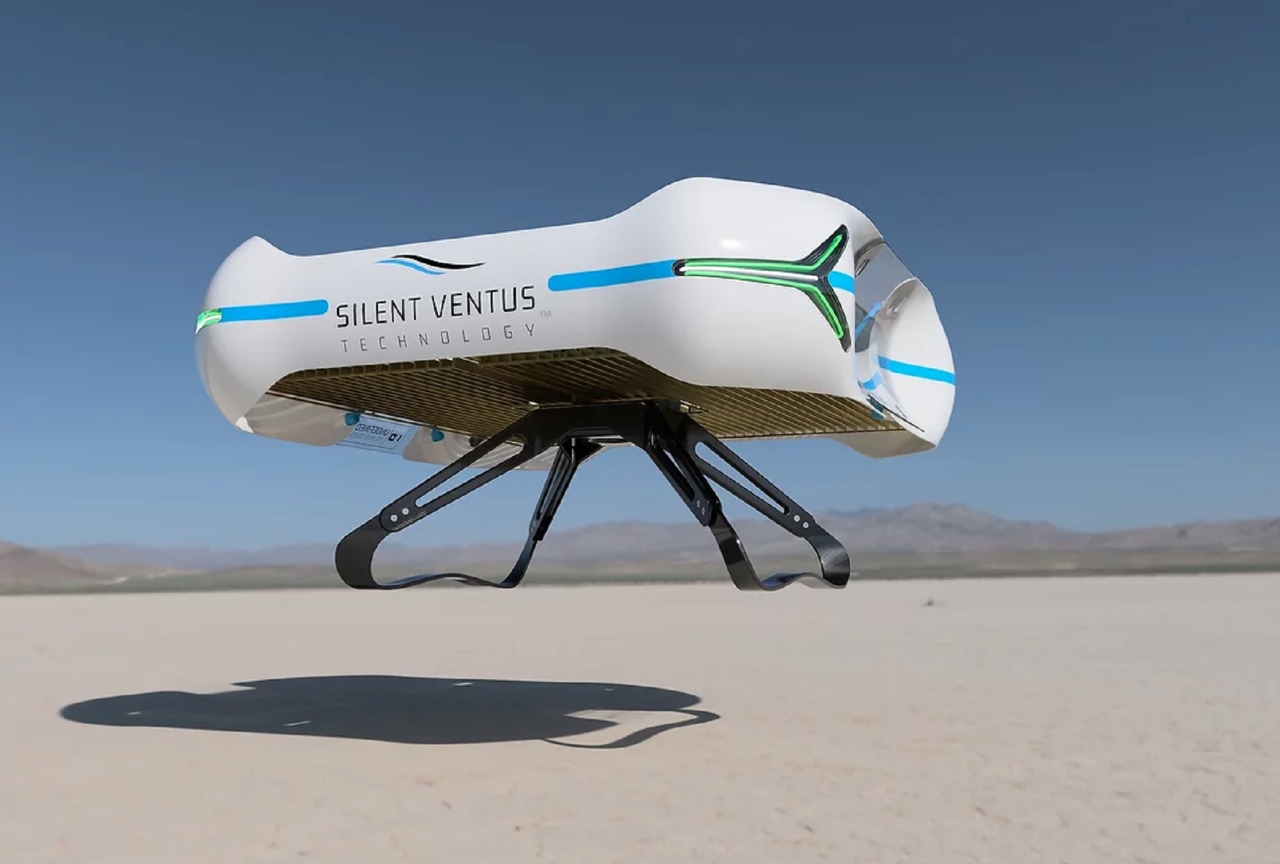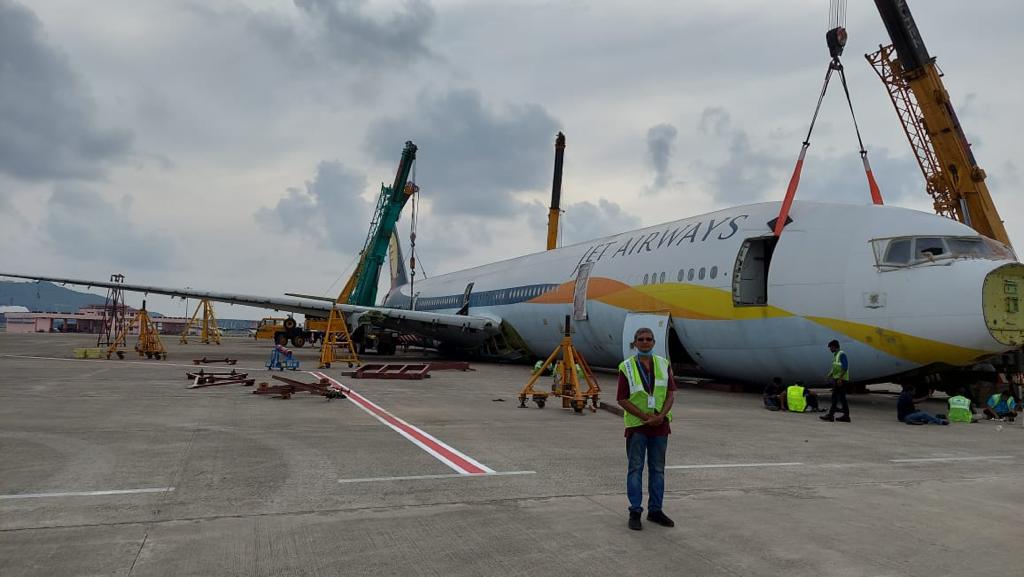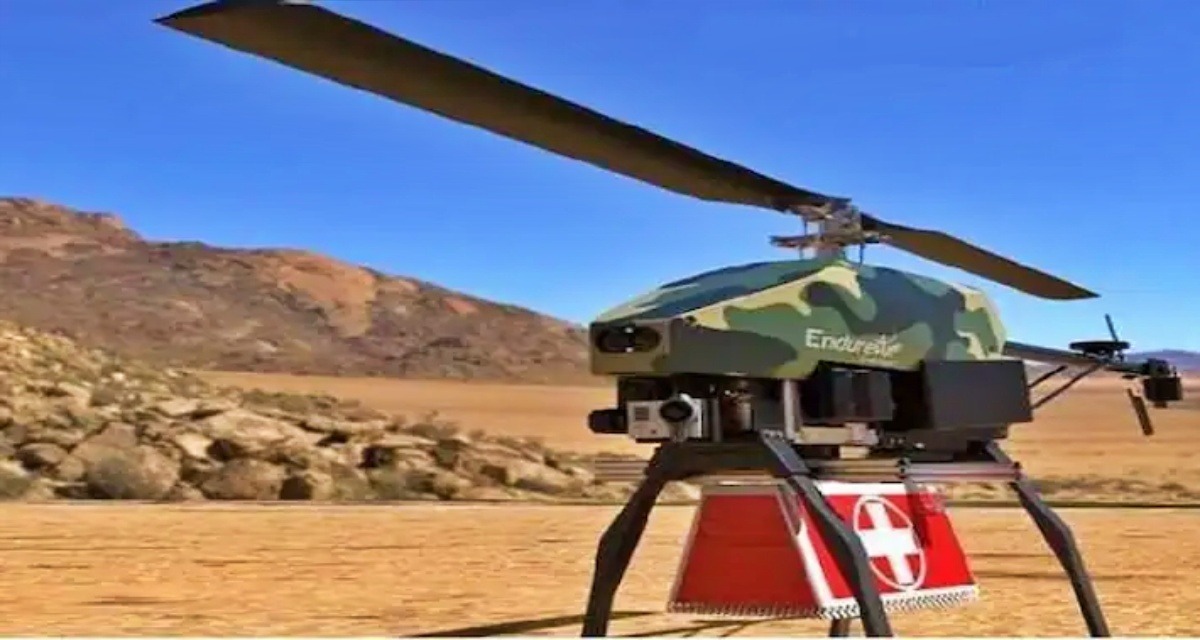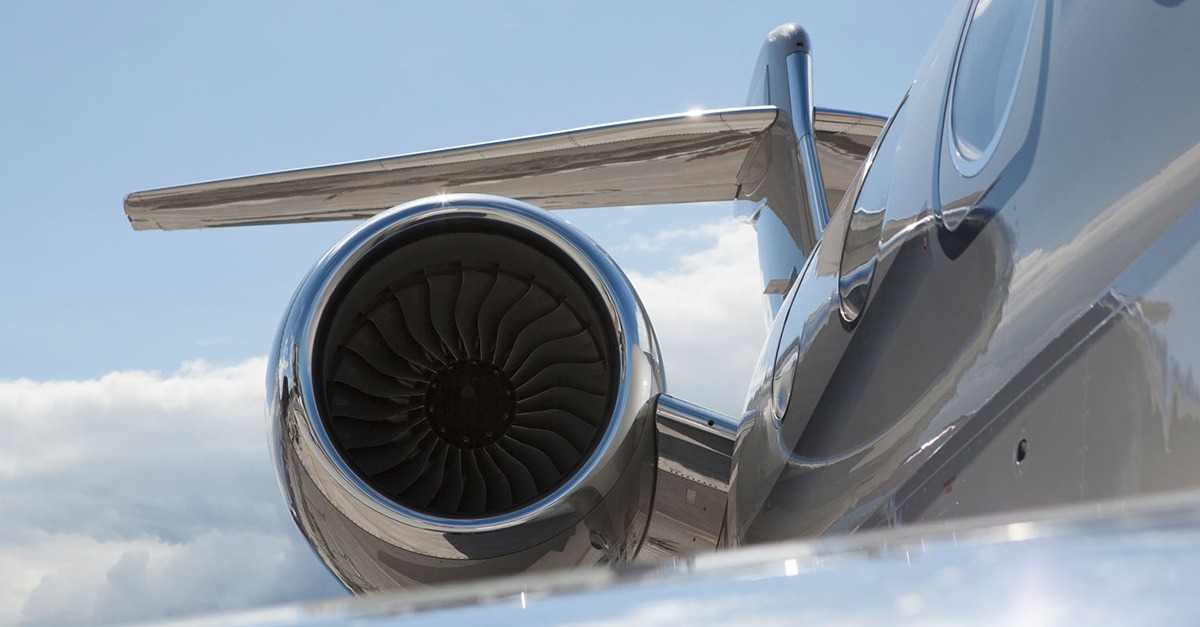Next-gen all-electric drone featuring ion-propulsion technology with a very low acoustic profile - is it really that silent?
Prashant-prabhakar
11 May 2022

If there's anything not-so-pleasing about a drone, it's the sound pollution caused by the propellors rendering the otherwise extremely useful aircraft, noisy.
I am concerned that drones are taking to the air without a lot of thought for the ears of people on the ground. Will there be a weight limit on delivery-drone payloads? Who will monitor the sound levels, and how? Should there be a curfew on hours of operation? There must be a reason companies don’t include the sound of the drone in advertising materials – and it’s probably not because they sound so nice. In this ad, the drone seems silentGarth Paine-Associate Professor of Digital Sound and Interactive Media, Arizona State University
An electric drone with absolutely zero noise levels and emissions might seem to exist in a utopian world, not in ours? Or, can they?
If reports are anything to go by, "Undefined Technologies"- a Florida-based tech startup, unveiled a new aesthetic design of its silent eVTOL drone last month, dubbed "Silent Ventus". It is unlike any other drone you've seen before and is reportedly powered by ion propulsion- touted to produce a very minimum noise signature.
Auto Evolution
Silent Ventus is a vivid example of our intent of creating a sustainable, progressive, and less-noisy urban environment. The design brings us closer to our final product and enables us to showcase the dual-use of our technology said Tomas Pribanic, Founder and CEO of Undefined Technologies
Tomas Pribanic | Commercial UAV News
Now for the main question- what is ion propulsion and is it practically possible?
Ion Propulsion
What is ion propulsion?
Theoretically, an ion thruster ionizes propellant by adding or removing electrons to produce ions. Most thrusters ionize propellant by electron bombardment-a high-energy electron (negative charge) collides with a propellant atom (neutral charge), releasing electrons from the propellant atom and resulting in a positively charged ion. In simple words, Ion thrusters eject ions instead of combustion gases to create thrust.
Illustrative | Online Star Register
Ideally, Ion thrust engines are practical only in the vacuum of space and cannot take vehicles through the atmosphere because ion engines do not work in the presence of ions outside the engine. Furthermore, the engine's minuscule thrust cannot overcome any significant air resistance.
Illustrative | NASA
Coming back to "Silent Ventus"- this concept vehicle reportedly uses proprietary technology to fully activate the ion cloud surrounding the craft, which is believed to generate high levels of ion thrust in atmospheric air, thereby pushing the flight to a near-silence environment.
According to the stats displayed on the website, commercial delivery drones generate between 85 and 96 dB of noise, while U.S. regulations allow for noise levels of 50 to 70 dB in residential, industrial, and commercial zones.
With the commercialization of this aircraft, the company hopes of achieving noise levels below 70 dB and has already shared footage of its prototypes completing test flight missions of up to two and a half minutes at below 85 dB.
https://www.youtube.com/watch?v=iihprC5Huf4
The company's ultimate goal is to slash the noise levels even further while at the same time, increasing the overall flight time, thereby making it feasible for a variety of applications, from last-mile delivery to civil, military operations and more.
Although, though much is not known about the "proprietary ion propulsion technology" at the moment, what we do know is that it uses “innovative physics, making it viable to use ion propulsion in atmospheric conditions with the superior performance of up to 160% compared to current ion thruster technologies.”
Scientifically, atmospheric ion propulsion usually generates minuscule thrust hence if there's an appreciable amount of thrust generated, this truly would be revolutionary in the world of drone propulsion.
SOURCE(s)
COVER: Auto Evolution
Read next
On Monday, May 9, the Supreme Court dismissed appeals against a Bombay high court decision upholding the GMR Group's concession rights to Nagpur airport.
In 2021, the Bombay high court's Nagpur bench ordered the multi-modal international cargo hub and airport in Nagpur, or Mihan, to execute the concession agreement with GMR Airports for the upgradation and operation of the city's Babasaheb Ambedkar International Airport.
The judgement of the High Court, said a bench of Justices Vineet Saran and J K Maheshwari, is based on sound reasoning and true analysis of facts and does not warrant interference.
The Supreme Court upheld GMR Infra's winning bid to modernise and operate Nagpur Airport
Mahan India, a joint venture between Maharashtra Airport Development Company and Airports Authority of India, had the award to GMR Group cancelled in 2020 because the Maharashtra government was unhappy with the revenue share quoted by GMR in the tender.
Mihan then decided to re-tender the job. GMR Infra will expand the capacity and modernise Nagpur Airport after the Supreme Court dismissed all appeals against the HC verdict on Monday, May 9.
GMR will now operate in Nagpur as well as Delhi, Hyderabad, and the soon-to-open Goa and Bhogapuram (Vizag) airports in India.
“In the present case, global tenders were invited and competitive bidding process was followed. The procedure of issuance of LoA (letter of award) is completely a fair procedure…we are of the considered opinion that the objection regarding non-joinder raised by the appellants is bereft of any merit and the High Court has rightly rejected the same.We are of the considered opinion that the findings recorded by the High Court allowing the Writ Petition are in accordance to the law. Those findings do not suffer from any illegality, warranting interference by this Court.… All these appeals are hereby dismissed."Supreme Court order
In October 2018 the group emerged as the highest bidder for the operation and management of Nagpur airport for thirty years offering 5.7% of its gross revenue to MIHAN
Subsequently, it agreed to share over 14% of gross revenue in post-bid negotiations and will hold a 74% stake in the project. Following that, Mihan issued a letter of award to GMR in March 2019.
GMR Infrastructure's share price gained nearly 3% on May 10 after the Supreme Court upheld a judgment of the Bombay High Court that had quashed a letter dated 19 March 2020 by MIHAN India annulling the bidding process for the Nagpur Airport.
GMR had emerged as the highest bidder in the tender process conducted by MIHAN India for Nagpur Airport in 2019
GMR had emerged as the highest bidder in the tender process conducted by MIHAN India for Nagpur Airport in 2019 and the letter of award was issued to the firm in March of that year.
However, Maharashtra decided to cancel the tender process in March next year and MIHAN India issued a letter annulling the bid process which was set aside by the Bombay High Court in August 2021.
As part of its modernisation plan for Nagpur's Babasaheb Ambedkar International Airport, GMR said that it will increase the ultimate capacity of the airport to around 30 million passengers annually, representing a capacity increase of over 1,000% in a phased manner. Currently, the airport handled a total of about 3 million passengers.
Read next
German mega carrier Lufthansa is planning to enhance its presence in India. And it wants to go beyond just flying its group airlines, that includes Swiss, to the country and is looking at increased cooperation with airlines here.
Both fellow Star Alliance members Air India, recently acquired by the Tatas, and Vistara, a joint venture between Tata and Singapore Airlines, are of special interest to the mega carrier for enhanced partnership opportunities.
Elise Becker, Vice President (Asia Pacific), Lufthansa Group
Elise Becker is responsible for the commercial activities of group airlines that including managing all airline sales JVs and partnerships in the region.
While talking to The Times of India, Industry insiders, say the partnerships could be in the form of tying up for aircraft maintenance and/or metal neutrality where, according to IATA, partner airlines share revenue and costs on a given route no matter which is doing the actual flying. This maximises the opportunity for pro-competitive efficiency gains from density economies.
“India, one of the most important airline markets worldwide, has seen a phenomenal recovery in air travel. We welcome the Tatas taking over Air India. Both Air India and Vistara have been long-term partners of our group and we hope to intensify our partnerships throughout India in the future.Lufthansa is a founding member of Star Alliance. It has always been a pioneer in forming partnerships and has participated in joint ventures in North America and Asia. 2022-23 will be a year when Lufthansa Group will seek to continue its path to increase its partnership scope India.As post-Covid, the world opens up for travel again, almost half of our Asia Pacific flights are to India. We will be adding more flights here operated by Lufthansa and Swiss. India is a very important market for us and we are keen on forging even deeper ties with the country."Elise Becker, Vice President (Asia Pacific), Lufthansa Group
Erstwhile Jet Airways had a metal neutrality pact with Air France-KLM. Having been the global head of partnerships at Lufthansa Group, Becker said it’s very important to be “strong in one’s home region and partner with strong airline partners in other regions” so customers have the best choice to any destination.
Becker told TOI recently on her first trip to India, “I am very impressed by the way India found its way back to normalcy.” She welcomed India’s decision to resume scheduled international flights from this summer schedule as that will “definitely boost India’s continued pandemic recovery.”
Lufthansa and Swiss will “steadily increase” services between India and Europe over the next months. Starting with 22 weekly frequencies between Delhi, Mumbai and Bengaluru with hubs in Frankfurt, Munich and Zurich, Lufthansa Group plans call to double this to 42 frequencies by July — getting close to pre-pandemic levels.
Lufthansa and Swiss will “steadily increase” services between India and Europe over the next months.
Lufthansa will resume Chennai-Frankfurt flights from April 29. It will operate its top aircraft to India, including the Boeing 747-8 and Airbus A350.
Lufthansa Group is investing billions per year until 2030 in technical state-of-the-aircraft like the A320neo, A350, Boeing 787 and 777-9.
“By 2025, 120 of these aircraft will join our fleet. It means on average, a new aircraft is added every two weeks. 2023 will see new seats in all classes at Lufthansa: first, business, premium economy and economy,” Becker said.
Read next
Chennai airport could soon become the hub for dismantling and repairing aircraft
Radhika Bansal
10 May 2022

Chennai could soon become the hub for dismantling aircraft as parts harvested in the city from abandoned aircraft are being sold to refurbish other aircraft around the world.
"The market is huge," said Pandian Sokku, managing director of Chennai-based maintenance, repair, and operations (MRO) company Nano Aviation India Pvt Limited.
Being the first in India to dismantle a Boeing 777 plane by the Jet Airways, his company is now flooded with calls to dismantle aircraft from across the country. "I have dismantled seven aircraft in Chennai and getting more orders," he said.
Being the first in India to dismantle a Boeing 777 plane by the Jet Airways
Used Serviceable Materials (USMs), which are taken out of abandoned aircraft and are installed in active commercial aircraft, are experiencing a high demand worldwide owing to their ability to lower the maintenance cost.
Notably, several MRO providers around the world are extensively using USMs owing to a rising number of ageing aircraft. As such, a majority of aircraft spares in the market are recycled ones.
They are sold after getting a certification from the authorities concerned. Many airlines use it, Pandian said.
Several MRO providers around the world are extensively using USMs owing to a rising number of ageing aircraft.
Earlier in India, spare parts of leased aircraft could not be imported or exported. Now, however, RBI has changed Foreign Exchange Management Act framework to allow Indian players to export leased aircraft, helicopters, and engines, either fully or knocked down.
ALSO READ - 8 airports identified by AAI for promoting Aircraft Maintenance, Repair and Overhaul activities
Chennai Airport Director Dr Sharad Kumar said there are two categories of aircraft — one that is turned into scrap due to its being grounded for a long and the other, recoverable. Recently, the Airport Authority of India auctioned four F-27 aircraft of the erstwhile NEPC Airlines. Scrap dealers bought these planes.
A B-777-300 ER, grounded by the erstwhile Jet Airways for over a year and belonging to the second category, however, was dismantled by Nano Aviation. There were also seven ATR 72-500 aircraft of the King Fisher Airlines, grounded in 2012.
Airport Authority of India auctioned four F-27 aircraft of the erstwhile NEPC Airlines. Scrap dealers bought these planes.
Three of them have been attached by the excise department for non-payment of taxes. Of the four aircraft, two have been purchased by Nano Aviation, said, Dr Kumar.
The dismantling of the Jet Airways plane took three months and provided jobs to 100 people, piquing the government's interest. "It also generated huge revenue and foreign exchange. As such, the government is looking to develop this sector similar to how it did with the Alang Ship Breaking Yard in Gujarat," said Pandian.
On Chennai's suitability for the sector, he said having a port nearby makes transportation easier. "I can't do it in Hyderabad or Bengaluru as I have to transport the spares by road to the port. In Chennai, the port hardly takes two to three hours away. About 90% of aircraft spares export is done via the sea," he said.
The MRO will be set up over 3,000sqm by the side of the secondary runway.
The Airports Authority of India has begun the paperwork to build a maintenance, repair and overhaul (MRO) facility near the second runway to encourage airlines to maintain their planes and turn Chennai airport into a hub.
The plan was suggested as part of the airport expansion project, which includes adding more facilities like the MRO, a fuel farm and more parking bays to equip the airport to handle passenger and aircraft traffic in the coming years as plans for a second airport are progressing slowly.
The MRO will be set up over 3,000sqm by the side of the secondary runway. The land has been earmarked near a set of parking bays and hangars. A tender has been floated to identify a contractor who will build and operate the facility for 30 years.
Aircraft and their parts can be stored, scrapped and recycled.
Firms interested in bidding will be visiting the airport in the coming weeks. The project is to be completed in a year. Sources said the MRO’s hangar will come up in front of a set of remote parking bays where planes can be parked. An airline hangar is also nearby.
Airliners are typically operated for 20 to 30 years. Corrosion, metal fatigue, and low availability of new spare parts are problems encountered in greater frequency the older a machine becomes.
Eventually, these factors, alongside improvements in fuel efficiency and reduction in maintenance cost of newer machines, reduce the economic viability of the operation of older airliners. Consequently, they may be stored, or scrapped and recycled.
Read next
Say hello to "VIBHRAM" - an indigenous UAV helicopter built for the army
Prashant-prabhakar
10 May 2022

Boosting the quest for "Atmanirbhar Bharat" - which aims at reducing foreign dependency in defence and aero technology further, a North Tech Symposium was held at Udhampur, Jammu - which showcased a variety of innovations in technological advancements.
Webdunia
Amongst various tech that was on display, "VIBHRAM"- a High-Efficiency Dissimilar Coaxial Helicopter, designed by a team of postgraduate students from the Aerospace Engineering Department of IIT Kanpur, was showcased as well.
A brief history
Back in August of 2017, 'Vibhram' won the third prize in the 34th Annual Student Design Competition organised by the American Helicopter Society.
Four years hence, the design was shown to the late Chief of Defence Staff, General Bipin Rawat on the occasion of Army Technology Day, on January 8, 2021. It was then shortlisted and displayed on Jan 15th on Army day for the Honorable Prime Minister of India in New Delhi.
Tech and specs
Designed to accomplish a variety of tasks, "VIBHRAM" is a high-endurance multi-role gasoline-powered Unmanned Aerial Vehicle.
Asianet Newsable
With a maximum hovering endurance of two hours, it features a day and night camera payload that can be useful for purposes like surveillance, chemical, biological, radiological, nuclear and high yield explosives detection, crowd monitoring, pipeline inspection, and forest fire detection among others.
It is capable of carrying four kilograms of payload at sea level at a speed of 70 km/h for long-range payload delivery and surveillance from a long standoff distance.
Installed with a fully functional and robust autopilot system, it additionally features multiple redundant fail-safe measures, which makes it a reliable tool in critical applications.
Apparently, this design has resulted in a new configuration for helicopters which is predicted to consume 5% to 20% less power than any existing helicopter concept in the world.
The fact that it is said to be around 20 per cent more efficient than the existing motor design like the traditional single main rotor and tail rotor and touted to consume less fuel in comparison to traditional helicopters, makes it worthy to be used by the army and the Air Force.
https://www.youtube.com/watch?v=KMHGInFLtec
Team Vibhram from IIT Kanpur
The project, which was carried out under the guidance of Prof Venkatesan and Prof Abhishek, was headed by Karthik S, who is pursuing MTech while Rahul Ramanujam is the technical leader, (PhD). The team further comprises Ramdas (PhD), Diksha Aggarwal (MTech), Sakshi Gupta (MTech), Avinash Shet (MTech), Vishesh Kumar Singh (MTech), and Naba Kishore Routray (MTech), all postgraduate students from Aerospace Engineering Department of IIT Kanpur.
SOURCE(s)
COVER: palpalnewshub
Read next
The international aviation community has set a roadmap of achieving zero emissions, or at least half of what is being produced right now, by 2050. Various strides have been made to improvise current propulsion systems to make them more efficient and environment-friendly.
Illustrative | Investable Universe
Aviation stalwarts have already begun experimenting and testing the technological feasibility of various propulsion systems-hydrogen, electric and ion propulsion to name a few. Current regulations now allow airlines to fly on 50% SAF and it will just be a matter of time before we start flying on 100% SAF.
ADS Group
Aviation H2, an Australian-based company, envisions minimizing the leaning of commercial aircraft towards standard Jet-A jet fuel, by burning green ammonia instead.
New Atlas
Wait, what? Yes, you heard that right.
The second-most produced chemical in the world today, ammonia is touted to be a promising source of energy carrier and source of future fuel, with interesting potential for decarbonizing aviation, rail and shipping alike. Although primarily used as a fertilizer, it is touted to move and store green hydrogen more effectively once the clean energy revolution kicks in.
Clean, renewable energy is produced at a point which is often miles away from where the demand is and hence, transportation becomes the catch. If that clean energy is used to electrolyze water and produce hydrogen, it can be stored and transported. Or better yet, that hydrogen can also be mixed with atmospheric nitrogen to produce ammonia, which travels much better than either gaseous or cryogenic liquid H2.
Hydrogen gas is very light for the energy it holds, and liquid hydrogen is even lighter. But the tanks are big and heavy. We certainly don't discount liquid hydrogen or any other form of hydrogen as an option. We're not shutting those down. We're just going with ammonia for now. It's the simplest conversion, and that intrinsically will make it the most reliable, and that in itself makes it intrinsically the safestAviation H2 Director Christof Mayer
Helmut Mayer-brother of Christof Mayer(pictured above) | New Atlas
How is it any better and cheaper than a hydrogen fuel cell conversion?
Mayer states that with a few modifications, a regular jet engine can be converted to run on ammonia, eliminating all its carbon dioxide emissions in a way that doesn't throw the baby out with the bathwater as opposed to a hydrogen fuel cell propulsion system which would require the turbofan engines to be replaced by electric motors as well as gutting the fuel storage systems and putting in something radically different.
Aviation H2
We need to modify the fuel storage system into something that's basically similar to an LPG tank. So it's the fuel storage, the engine control, and the engine, those are the big ticket items that we need to develop. But we're not really changing the design of the engine much at all physicallysays Mayer
Illustrative | New Atlas
However, with all being said, there's still an inevitable catch. As the hydrogen in ammonia is broken off during combustion, it joins with atmospheric oxygen to form water, while a percentage of the nitrogen also gets oxidized in the flame, causing environmentally harmful nitrous oxides.
Yes, it gives off nitrous oxides. But we can control those by special processes. We don't just squirt the ammonia in there and burn, there's certain things we have to do to it, and there's certain controls we have to put in place inside the fuel control systemSays Mayer
Starting, the company plans to get a small regional nine-seat jet built and flight tested. It has, apparently, signed an agreement with charter operator FalconAir, giving Aviation H2 access to FalconAir's hangars, facilities and operating licenses. The aircraft is expected to do hour-long flights, with the same engine thrust and performance characteristics as it would get on Jet-A.
As a part of the "proof of concept" flight, the company plans to get the aircraft in the skies with at least one engine running on ammonia, by mid-2023, which, could be a first for jet-powered aviation.
Eventually, Aviation H2 hopes to begin retrofitting existing planes as a transitional step for carriers looking to decarbonize, taking advantage of the fact that the rest of the aircraft is already fully certified to bring down compliance costs.
SOURCE(s)
COVER: NBAA



Comment